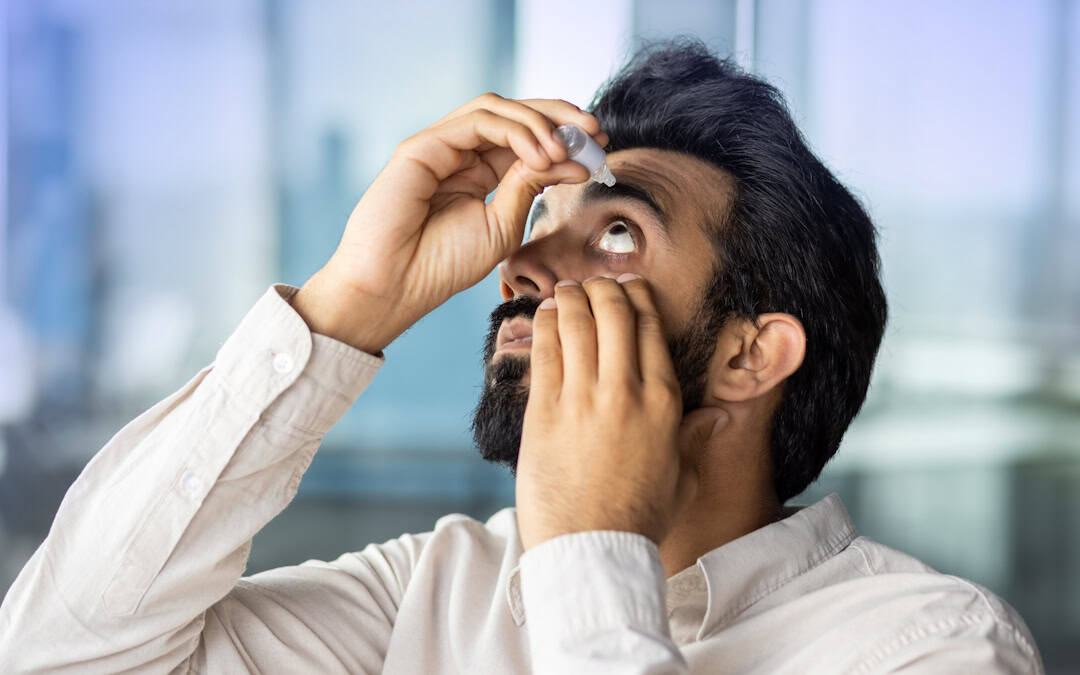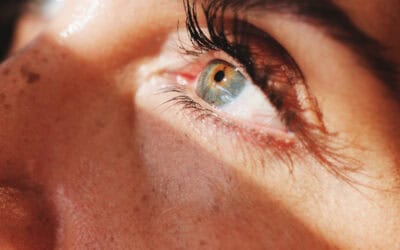Over 20 million people in the United States suffer from dry eye disease, yet most don’t realize their scratchy, irritated eyes might be warning them about serious underlying health problems. What feels like a simple annoyance could actually signal autoimmune disorders, hormonal imbalances, or other systemic conditions that require medical attention.
Your tear film consists of three delicate layers that work together to protect your eye’s surface. When this system breaks down, not only do your eyes feel uncomfortable but they also may be telling you something important about what’s happening inside your body.
Dry eye involves much more than simply not producing enough tears. Two distinct types affect millions of people: aqueous deficient dry eye occurs when your lacrimal glands fail to produce adequate tears, while evaporative dry eye happens when tears disappear too quickly from your eye’s surface.
Age plays a significant role in tear production. Adults over 50 face higher risks as their natural tear production declines with each passing year. Women experience even greater challenges during pregnancy and menopause when hormonal shifts make it harder for their bodies to maintain healthy tears.
Your medications might also be working against your eye comfort. Tranquilizers, antihistamines, heart medications, diuretics, birth control pills, and ulcer medications can all trigger dry eye symptoms as an unwanted side effect. Certain medical conditions create additional risks, including Sjogren’s syndrome, allergic eye disease, rheumatoid arthritis, lupus, scleroderma, and thyroid disorders.
When your eyes feel persistently dry, they might be trying to communicate something crucial about your overall health.
Understanding these root causes matters because your dry eyes often serve as early warning signs for conditions that affect your entire body. When your eyes feel persistently dry, they might be trying to communicate something crucial about your overall health that deserves immediate attention.
Why Dry Eye is Often Misunderstood
Most people, and unfortunately, many healthcare providers, still think about dry eye the wrong way. These persistent misconceptions lead to treatments that provide only temporary relief while the real problems continue damaging your eyes.
The “Just add Tears” Myth falls apart
For decades, dry eye seemed simple: not enough tears meant dry eyes. This oversimplified view has created more problems than it solved.
The reality tells a different story. Some people with severe dry eye symptoms actually produce excessive tearing as their eyes desperately try to compensate for poor tear quality. Your eyes flood with tears that don’t actually help because the underlying problem isn’t quantity—it’s quality.
Over-the-counter artificial tears offer temporary relief at best. These drops can’t address the root causes that make your tear film unstable in the first place. When the drops wear off, your discomfort returns because the fundamental problem remains untouched.
What really matters: tear film stability
Your tear film operates as a sophisticated three-layer system: an oily outer layer, a watery middle layer, and a mucus inner layer. Each layer serves a specific purpose in protecting your eye’s surface.
Even when your tear glands work perfectly, your eyes can still feel painfully dry. The problem lies in tear film instability, which is a condition when tears evaporate too quickly or fail to spread evenly across your eye’s surface. It is this instability, and not tear volume, that causes most dry eye discomfort.
Here’s another way to think about it: having a leaky roof doesn’t get fixed by adding more water to your house. You need to repair the roof itself.
The hidden culprit: blocked oil glands
Meibomian gland dysfunction (MGD) causes the majority of evaporative dry eye cases. These tiny oil-producing glands along your eyelid edges prevent your tears from evaporating too quickly.
When these glands become blocked or produce poor-quality oil, your protective tear layer breaks down rapidly. This problem is fairly common as over 35% of people worldwide have MGD, with the rate jumping to 70% among Americans over 60.
Unfortunately, the problem creates a destructive cycle. Poor oil quality leads to faster evaporation, which causes tear film instability, increased salt concentration, inflammation, and ultimately damage to your eye’s surface. Each problem feeds the others, making simple tear drops ineffective.
Understanding these mechanisms explains why the “just add more tears” approach fails so consistently. Your eyes need personalized treatment that addresses what’s actually going wrong with your tear film system.
Overlooked Causes of Dry Eye Symptoms
Several hidden factors contribute to your dry eye symptoms, yet most doctors never ask about them during routine visits. These overlooked causes often hold the key to understanding why standard treatments fail to provide lasting relief.
Changes in diet and omega-3 deficiency
Your diet directly affects how well your eyes produce tears. Research shows omega-3 fatty acids play a crucial role in tear production and stability. Studies demonstrate that omega-3 supplementation significantly improves tear breakup time and tear production in dry eye patients. The mechanism involves reducing inflammation and enhancing the oil film produced by meibomian glands.
People who consume more omega-3-rich foods like fatty fish show a reduced risk of developing dry eye. The Women’s Health Study (WHS) found that a higher ratio of omega-3 to omega-6 fatty acid consumption was associated with significantly reduced risk of dry eye in women. Many people consume far too much omega-6 fatty acids from processed foods while getting insufficient omega-3s from sources like salmon, sardines, and walnuts. This imbalance creates inflammation throughout your body, including your eyes.
Altered lid microbiome and bacterial enzymes
The bacteria living on your eyelids affect tear film stability more than you might expect. Research reveals dry eye patients have different bacterial populations compared to those without the condition. These bacteria, especially Staphylococcus epidermidis, produce lipases and toxins that can destabilize the lipid layer of tears.
Studies show decreased bacterial richness and diversity in females with dry eye compared to males, which may contribute to the higher prevalence of dry eye in women. This bacterial disruption is often unrecognized during standard eye exams.
Nocturnal exposure and incomplete eyelid closure
You might not realize your eyelids don’t fully close during sleep. Nocturnal lagophthalmos—the inability to completely close your eyelids during sleep—is a surprisingly common yet underdiagnosed cause of dry eye symptoms. This condition is associated with worsened dry eye symptoms and poor sleep quality. When eyes remain partially open during sleep, the tear film undergoes excessive evaporation, leading to morning dryness and irritation.
Many people wake up with dry, gritty eyes and never connect this discomfort to incomplete eyelid closure during the night.
Digital screen use and reduced blinking
Screen time dramatically affects blinking patterns. Studies show your blink rate decreases from 22 blinks per minute when relaxed to just 7 blinks per minute when viewing digital screens. Nearly 60% of Americans use digital devices for at least 5 hours daily, with 70% using multiple screens simultaneously.
Screen use reduces both blink frequency and completeness, preventing proper tear film distribution across the eye surface. This effect is especially concerning in children, where excessive smartphone use has been linked to dry eye development. When you don’t blink completely, your tears can’t spread evenly across your eye’s surface, creating dry spots that become increasingly irritated throughout the day.
Learn helpful strategies for making screen time more comfortable in this article from the eye care experts at Chang Eye Group in Pittsburgh.
From Symptoms to Systemic Clues
Ongoing dry eye symptoms might be your body’s way of alerting you to serious health conditions that extend far beyond your eyes. Rather than dismiss that scratchy, uncomfortable feeling, these warning signs deserve careful attention because they often appear before other symptoms of systemic diseases become obvious.
When dry eyes point to autoimmune disease
Autoimmune disorders frequently announce themselves through your eyes first. Sjögren’s syndrome, an autoimmune disorder that causes dry eyes and mouth, affects approximately 94% of patients with dry eye symptoms, developing when your immune system mistakenly targets the glands that produce moisture. The connection runs even deeper with rheumatoid arthritis patients, who show a 70% prevalence of dry eye disease even without secondary Sjögren’s. And about 16% of patients with systemic lupus erythematosus experience dry eye symptoms.
These conditions share a common mechanism: T lymphocytes infiltrate your lacrimal glands, disrupting normal tear production and creating the persistent discomfort you feel. Ongoing dry eye symptoms may be the first sign that your immune system has begun attacking your own tissues.
How dry eye links to hormonal shifts
Hormonal changes can also significantly affect your tear production. A recent study found that nearly 79% of perimenopausal and menopausal women developed dry eye disease conditions with over 37% having severe symptoms. Research is ongoing to the causes including how decreasing androgen levels directly impact both meibomian and lacrimal glands.
Studies also have found that women undergoing hormone replacement therapy face a greater risk of developing dry eye symptoms. Even conditions like polycystic ovarian syndrome alter sex steroids in ways that create ocular surface disturbances, often described as “itchy-dry eye-associated syndrome”.
Your hormones and eye comfort are more connected than most people realize, which explains why women experience dry eye at much higher rates than men.
The connection between dry eye and mental health
Mental health conditions and dry eye disease combine to affect both your emotional well-being and physical comfort. Studies reveal that depression and/or anxiety occurs in more than 39% of dry eye patients, much more often than for people without the condition. Most remarkably, patients who screen positive for depression consistently show both more severe dry eye symptoms and worse clinical findings during eye exams.
This creates a bidirectional relationship where dry eyes worsen mental health, while depression and anxiety make dry eye symptoms feel more severe and harder to manage. Read more about how depression can affect your vision in this article from Chang Eye Group in Pittsburgh.
Understanding these connections helps explain why treating dry eye often requires addressing the whole person, not just the surface of your eyes.
A Smarter Approach to Diagnosis and Relief
Generic eye drops from the pharmacy shelf rarely provide lasting relief because they don’t address what’s actually causing your dry eye symptoms. Effective treatment starts with pinpointing the specific problem affecting your tear film.
Why a comprehensive eye exam is essential
Your eye doctor needs to determine whether you’re dealing with insufficient tear production, rapid evaporation, or inflammation before recommending treatment. A slit lamp examination reveals your tear film quality under magnification, while a Schirmer’s test measures how much tears your eyes actually produce. The tear breakup time (TBUT) test shows how quickly your tears disappear from your eye’s surface.
These specialized tests matter because targeting the wrong mechanism leads to treatment failures. If your dry eye stems from blocked oil glands, adding more artificial tears won’t solve the underlying blockage.
Combining home care with clinical treatments
The most successful dry eye management combines simple home remedies with professional interventions tailored to your specific condition. Warm compresses can help unblock oil glands, while omega-3 supplements support tear film stability and eyelid hygiene routines remove irritating debris.
Professional treatments range from prescription anti-inflammatory drops to advanced procedures. Meibomian gland expression manually clears blocked oil glands, punctal plugs help retain tears on your eye’s surface, and Intense Pulsed Light therapy addresses inflammation. These treatments combined have improved symptoms in over 85% of patients in recent studies.
The dry eye clinic in Pittsburgh at Chang Eye Group offers these specialized treatment options designed to restore your natural tear film function rather than just mask symptoms.
The importance of personalized treatment plans
Your dry eye symptoms are as unique as you are. What works for your neighbor might not work for you because the underlying causes often differ significantly.
Your treatment plan should evolve as your condition changes. Here in Pittsburgh, your symptoms might worsen due to seasonal allergies in spring, while indoor heating could create winter flare-ups that require changes to your eye care. Regular monitoring by our experienced eye doctors ensures your treatment stays effective as your needs change over time.
The most effective approach focuses on restoring your natural tear film stability rather than relying solely on artificial substitutes. This philosophy addresses the root problem instead of temporarily covering up symptoms.
Taking Action for Your Eye Health
Your dry eyes are trying to tell you something important about your body. This is not about comfort but rather truly protecting your vision and catching potentially serious health conditions before they progress.
Dry eye symptoms often signal underlying conditions that affect your entire body.
Dry eye symptoms often signal underlying conditions that affect your entire body. When your eyes feel persistently scratchy or irritated, they might be warning you about autoimmune disorders, hormonal changes, or other systemic issues that require medical attention.
Don’t ignore what your eyes are telling you.
Generic eye drops from the store won’t address the root causes we’ve explored. Whether your symptoms stem from blocked oil glands, dietary deficiencies, or incomplete eyelid closure during sleep, you need proper diagnosis to find lasting relief.
The good news is that effective treatments exist when you address the underlying problem rather than just masking symptoms. Modern dry eye care combines targeted therapies that restore your natural tear film stability with lifestyle modifications that support long-term eye health.
Your eyes deserve more than temporary relief. They deserve care that addresses why your symptoms developed in the first place. A qualified eye specialist can determine whether you have aqueous deficient or evaporative dry eye and create a treatment plan specifically for your situation.
Remember that your dry eye symptoms might be your body’s way of alerting you to health issues that extend far beyond your eyes. Taking action now protects both your vision and your overall wellness for years to come.
Chang Eye Group specializes in identifying and treating the root causes of dry eye disease. Our experienced team can help you understand what your symptoms mean and develop an effective treatment plan that goes beyond temporary fixes. Call today to schedule your evaluation at one of our convenient locations in Pittsburgh to take the first step toward lasting relief.
FAQs
Q: Can dry eyes indicate a more serious underlying condition?
A: Yes, dry eyes can be a sign of underlying health issues. They may point to autoimmune disorders like Sjögren’s syndrome, rheumatoid arthritis, or lupus. Dry eyes can also be linked to hormonal imbalances and even mental health conditions like depression and anxiety.
Q: What are some effective treatments for severe dry eye?
A: Treatment for severe dry eye often involves a combination of approaches. These may include prescription eye drops to control inflammation, tear-stimulating drugs, and in some cases, eyedrops made from your own blood. Advanced procedures like meibomian gland expression or Intense Pulsed Light therapy can also be effective for many patients.
Q: Is it possible to completely cure dry eye syndrome?
A: While there’s no permanent cure for dry eye syndrome, it can be effectively managed with proper treatment. The key is to identify the underlying cause and develop a personalized treatment plan that may include a combination of home care and clinical interventions.
Q: How does screen time affect dry eye symptoms?
A: Excessive screen time significantly impacts dry eye symptoms. It reduces blink rate and completeness, preventing proper tear film distribution across the eye surface. Studies show that blink rate decreases from 22 blinks per minute when relaxed to just 7 blinks per minute when viewing digital screens.
Q: Can dietary changes help alleviate dry eye symptoms?
A: Yes, dietary changes can help with dry eye symptoms. Increasing intake of omega-3 fatty acids, found in fatty fish and supplements, can improve tear production and stability. Studies have shown that omega-3 supplementation significantly improves tear breakup time and reduces the risk of developing dry eye.






